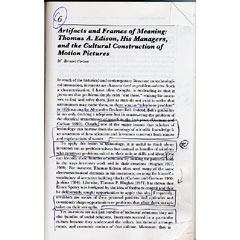
NOTE: This essay is Chapter 6 (pages 175-200) of Bijker & Law (1992) - Shaping Technology / Building Society: Studies in Sociotechnical Change
[175-176] {inventors, innovation, culture, solution, problem, institutions, artifacts, customers, marketing, manufacturing, social technological, production, consumption} ...it is useful to think about inventors not as problem-solvers but instead as bundles of solutions who construct problems suited to their unique skills and ideas... Frequently, inventors are aware of their personal patterns and aptitudes and consciously shape opportunities or problems that allow them to capitalize on their strengths. Yet inventors are not just bundles of technical solutions; they are also bundles of social solutions. Inventors succeed in a particular culture because they understand the values, institutional arrangement, and economic notions of that culture. Moreover, they are often willing and able not only to invent technological artifacts but also to modify the social and economic arrangements needed for that artifact to come to use... Thus in the course of developing an invention, inventors combine technical and social solutions. They know that success comes from interweaving the social and technical in ways that make it impossible to unravel and separate the two. Put in more specific economic terms, they achieve this interweaving by securing patents, establishing a business for manufacturing and marketing, and attracting customers. Inventors seek profits and fame by linking their artifacts with social organizations for production and consumption.
[177] {artifact, invention, frame of meaning, economics} Let me emphasize that inventors and entrepreneurs must not only construct the hardware or artifact but simultaneously fashion frames of meaning. If they fail to do so, then they are often unable to sell their creation to investors or consumers.
[178] {Edison, film, movies, consumer, producer, 19th century, 20th century, transition} ...Edison developed his motion picture technology just as America was experiencing the transition from producer to consumer culture. Although Edison invented within the producer culture of the nineteenth century, his movie audiences and his competitors were participating in twentieth-century consumer culture.
[180-181] {Edison, business, commerce, marketing, market, masses, pop, manufacturing, distribution} Edison preferred to produce inventions that could be used by Western Union or other large firms... Edison quite sensibly concluded that mareting a new technology to the general public was best done by businessmen who knew the local customs. As a result, Edison focused his efforts on producing machine for business markets and avoided marketing products to the masses. Wherever possible, Edison tried to make money by manufacturing his inventions and externalizing marketing and distribution.
[183] {Edison, kinetoscope}
[183] {Edison, industrial revolution, 19th century} Edison's strength was in inventing machines that contributed to the "second industrial revolution" of the late nineteenth century.
[185] {1896, Edison, projection}
[187-189] {Edison, film, movies, middle class, working class, class, market, nickelodeon, censorship} First, the Edison organization produced films that established middle-class values and mores; the company was known for its wholesome comedies, biblical stories, and patriotic historical dramas... Second, rather than cater to the urban working class, Edison and his managers became concerned that the middle class was not patronizing nickelodeons... Third, the Edison organization supported the efforts to censor movies... [and a] refusal to develop a star system.
[190] {consumer culture, Edison, celebrity, amusement}
[191] {kinetophone, audio, film, sound, silent, Edison, skill} The kinetophone system proved unsuccessful because it was dependent on the skill of the operator and because theater rats liked to chew through the control strings.
[192-193] {remediation, Edison, new, old, media, invention, consumer culture, frame of meaning, cultural creep, kinetoscope} This case study shows well how the invention process involves the creation and linking of technological artifacts and frames of meaning.... Both Edison's producer values and the middle-class bias of his managers ran counter to the emerging consumer culture... Rather than inventing a new frame of meaning specifically for this artifact, both Edison and his associates used preexisting frames based on their previous experiences... With the kinetoscope Edison transferred his frame of meaning from one machine to another; rather than consciously shape new meanings to fit the new technology, Edison let them "creep" into his design.
[193] {remediation, cultural creep, frame of meaning, new, old, media, invention, consumer culture, revolution, revolutionary, inventor, entrepraneur, culture, paradigm} Although we have come to expect that new technologies are revolutionary, I suspect that at the level of individual innovators and managers the process of cultural construction is often one of "cultural creep." By this I would suggest that inventors and producers often create artifacts to fit into cultural spaces suggested by their existing frames of meaning. Often, an inventor's survival depends on fitting into the existing order, not on consciously overthrowing it. It is only after the invention is put onto the market that consumers and other entrepraneurs use it in new ways and alter its cultural meanings.
[195] {Edison, consumer culture, production culture, 19th century, 20th century, America, new, electric light, telephone, phonograph} It is true that he provided many of the basic technological artifacts of this new culture -- the electric light, the telephone, and the phonograph - but he never understood the new culture that grew up around these devices. Edison led Americans to the Canaan of consumption, but steeped in his nineteenth-century values of production, he was unable to enter that promised land.
